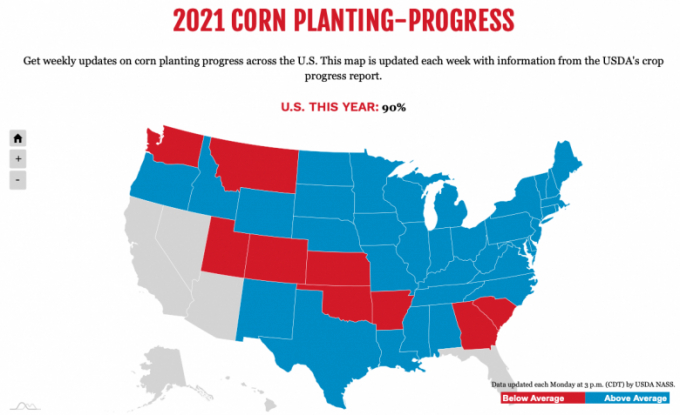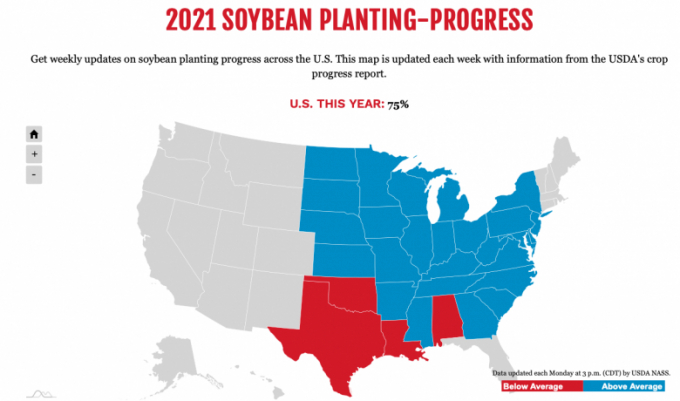October 12, 2025 | 10:37 GMT +7
October 12, 2025 | 10:37 GMT +7
Hotline: 0913.378.918
October 12, 2025 | 10:37 GMT +7
Hotline: 0913.378.918
Emergence of both crops remains ahead of five-year averages, according to the USDA Crop Progress Report.
As of Sunday, the U.S. had 90% of the corn crop planted, above an 80% five-year average and equal to the trade’s expectations.
CORN
As of Sunday, Illinois farmers seeded 90% of this year’s corn crop vs. a 79% five-year average. Iowa farmers have put 97% of their corn in the ground vs. their 90% five-year average. So far, Nebraska has planted 95% of its corn vs. a 89% five-year average.

Of the total U.S. corn planted, 64% has emerged, above the 54% five-year average.
Over half of the Indiana, Illinois, and Nebraska corn crops are out of the ground.
SOYBEANS
As of Sunday, the USDA rated the nation’s soybean crop as 75% planted vs. a 54% five-year average.

Indiana’s farmers have 41% of their soybeans out of the ground vs. a 24% five-year average. Iowa's farmers have 53% emergence of soybeans vs. an 26% five-year average. The crop in Illinois is 60% emerged vs. a 30% five-year average.
WHEAT
In its report Monday, the USDA rated the U.S. spring crop as 45% good/excellent.
The U.S. winter wheat crop is rated as 42% good/excellent vs. 48% a week ago.
Crop progress and condition estimates are based on survey data collected each week from early April through the end of November, according to the USDA report. “The non-probability crop progress and condition surveys include input from approximately 3,600 respondents whose occupations provide them opportunities to make visual observations and frequently bring them in contact with farmers in their counties. Based on standard definitions, these respondents subjectively estimate the progress of crops through various stages of development, as well as the progress of producer activities. They also provide subjective evaluations of crop conditions,” the USDA stated in its Monday report.

The U.S. winter wheat crop is rated as 42% good/excellent vs. 48% a week ago.
Most respondents complete their questionnaires on Friday or early Monday morning and submit them to the National Agricultural Statistics Service (NASS) field offices in their states by mail, telephone, fax, email, or through a secured internet website. A small number of reports are completed on Thursday, Saturday, and Sunday. Regardless of when questionnaires are completed, respondents are asked to report for the entire week ending on Sunday, according to the report.
(SF)

(VAN) The people who are most vulnerable to the hard-to-breathe air that comes with climate change may inadvertently be adding to the problem, new research finds.

(VAN) Director-General QU Dongyu announces series of initiatives following global livestock conference.

(VAN) China’s freeze on U.S. soybean purchases hits a key GOP constituency in the run-up to 2026 midterm elections.

(VAN) President Xi Jinping's festive greetings ahead of the eighth Chinese Farmers' Harvest Festival, which fell on Tuesday this year, were a clear signal that China regards food security as a core strategic issue.

(VAN) BBNJ Agreement will enter into force in January.

(VAN) Demonstrations have been planned around the world this week ahead of the United Nations General Assembly and New York Climate Week.

(VAN) After years of intense deliberation, the European Commission has finally given its nod to the Mercosur and Mexico agreement.